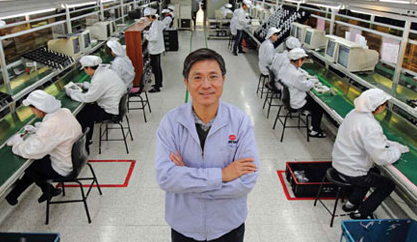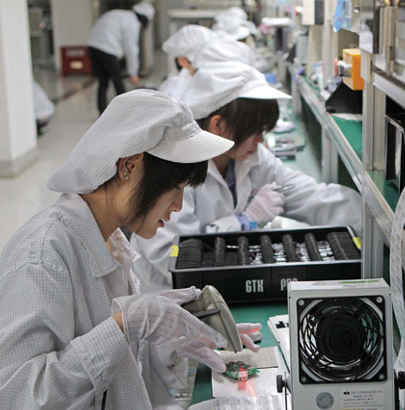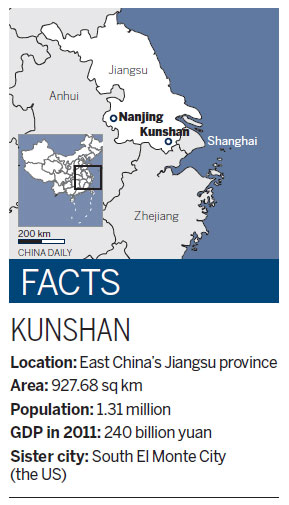Excess of success
Updated: 2012-02-24 08:27
By Wang Ying (China Daily)
|
|||||||||||
|
|
| ||||
With the help of advanced electronics manufacturing, the town can boast of an economy worth 240 billion yuan ($38 billion, 29 billion euros), which has made it the most developed county-level region in China. Per capita GDP in 2011 was $24,000, comparable with that of South Korea.
Zuo Xuejin, executive vice-president of the Shanghai Academy of Social Sciences, says that Kunshan's economy got to where it is by making the most of sprawling land and labor and with great dollops of foreign investment. Now, he says, the town needs to look at the way it goes about its business if it wants to retain, or regain, its advantage over other inland cities in the realms of policy support and labor costs.
Kunshan's star began to shine brightly in 1990, when a textile company in Taiwan, attracted by the town's proximity to Shanghai, decided to invest here. Other firms in Taiwan soon followed suit.
Since then, Kunshan has become a magnet for business people and their families, and for the local government, capital, technology and sales networks.
Four thousand businesses from Taiwan are now here, and about 100,000 people from the island live in the town. The value of their investment is more than $45 billion (34 billion euros).
Almost two-thirds of the largest manufacturers in Taiwan have set up shops in Kunshan, including Compal Electronics Inc, the world's second largest original design manufacturer of laptop computers after its Taiwan peer Quanta Computer Inc, as well as the world's largest electronics manufacturer, Foxconn Technology Group, which makes components in Kunshan.
Compal alone exported $14 billion from its Kunshan facilities in the first 10 months of last year.
|
|
Guan Aiguo, Party secretary of Kunshan, said in June that the electronics and technology industry accounted for two-thirds of its economy.
Spurred by the financial crisis in 2008, many electronics makers started to shift production to western China to cut labor costs and to take advantage of government incentives.
Last year almost all big laptop computer brands including HP, Lenovo and Dell, as well as their manufacturers such as Quanta, Foxconn and Compal, announced they were setting up plants in Chongqing and Chengdu.
Just as Kunshan has never been shy about its economic prowess, Chongqing is straightforward about its ambitions when it comes to laptop computers. Huang Qifan, the municipality's mayor, addressing deputies of the legislature last month, said 25 million laptop computers were made in the city last year and the goal is to double that this year. Chongqing's five-year plan (2011-15) calls for 100 million laptop computers to be made.
As the tablets and smartphones epitomized by Apple's Inc's iPhone and iPad change the way people go about their lives and the way companies do business, they are also reshaping China's national economic geography.
Kunshan, long a beneficiary of that revolution, is now feeling squeezed as the machines that keep the revolution ticking over are called in for inspection. The inspectors' message to Kunshan is clear: your costs, including for labor, are way too high.
In the first nine months of last year the value of Kunshan's electronics and machinery exports, accounting for 85 percent of all exports, was $34.7 billion, a fall of 2.3 percent year-on-year.
"Once the industry goes into the low season, working in single-engine mode will be destructive to the city's economy," says Chen Wei, a researcher at the Shanghai Academy of Social Sciences who specializes in regional economies. "Kunshan should try to move up the industry chain and put more money into research and development, marketing and other things. Then the city could well develop into an IT innovation center turning out creative ideas, designs, and new-generation products."
The city's leaders, rather than being downcast about the city's fortunes, are trying to see the challenges as a historic opportunity for industrial renewal. In recent years the city has set aside 6 percent of its finances to promote technological innovation. That means the city pumped about 1 billion yuan into industrial renewal last year, says Guan, the city's Party chief.
|
 Lee Chin Ping, president of Mitac Computer (Kunshan). [Gao Erqiang/China Daily] |
Kunshan aims to achieve "basic modernization", synonymous with the level of a moderately developed country, this year, he says.
The 28 indices used to measure the modernization include: per capita GDP should reach $20,000 ($21,469 in 2010), the percentage of research and development investment in GDP should be 2.8 percent (2.2 percent in 2010), the contribution of foreign-invested businesses to GDP should be 50 percent (60 percent in 2010), and the contribution of high-tech and new industries to total industrial output should be 40 percent (37.5 percent in 2010).
Guan says Kunshan has made machinery, with electronics, one of its pillar industries. In addition, it plans to develop new industries such as opto-electronics, robotics, bio-medicines, software and technology service outsourcing and radio frequency identification technologies.
Liang Wengen, chairman of China's third largest construction machinery maker, Sany Group, the richest Chinese company ranked by Forbes magazine, says the company has been making cranes and excavators in Kunshan since 2006. Sales that year were worth 2 billion yuan, and sales last year are estimated to have been 10 times that.
The company has developed its most advanced cranes in Kunshan, one of which can lift 3,600 tons, said to be a world record.
In 2010, the city's new industries accounted for almost 160 billion yuan of industrial output, about 23.4 percent of the total.
On Jan 30, 105 projects started construction in Kunshan, with total investment of 60.8 billion yuan, including 21.8 billion yuan this year. Investment in 43 new and high-tech industries is 15.4 billion yuan, while that in services for 37 projects is 36 billion yuan.
Another company that gives Kunshan good reason to be optimistic is ASE, the world's largest semiconductor testing and packaging company.
China News Service has quoted J. A. Hsu, vice-president of the Kunshan operation of ASE, as saying that since 2004 the company has invested $599 million in the town. He said that over the next five years ASE, whose headquarters is in Taipei, would hire 90,000 people in Kunshan and the value of annual output there would be as high as $10 billion.
Mitac Computer (Kunshan) Co Ltd, which specializes in navigational equipment, is another company with headquarters in Taiwan that has staked a lot on the town.
All of its products are made in Kunshan, and 60-70 percent of the company's research and development is done there.
"We are waiting for the market to mature," says Lee Chin Ping, the company's president. "Once people realize that it makes sense to buy a well-known brand's navigational gear, even at a premium price, we will raise output."
Most of the company's products are exported, he says.
Chen Chun Tang founded Elegance Group in Kunshan in 1993 and has watched it develop from a company that made clothes into a group whose activities include food processing and even giving factory tours.
Chen reckons his golden rule is to adapt to the changing environment. "Like many other businessmen from Taiwan, I invested the hopes and savings of the family in the business, so we cannot afford to lose."
The outlay was $600,000, and aided by the mainland's abundant labor resources, the group is now reckoned to be worth between $20 million and $30 million.
But in recent years, the company has begun to outsource orders to factories in Guangdong province because of a shortage of labor.
"We should spend more on brand promotion, technology innovation, and move higher up the industry chain," Chen says.
Despite the world's financial woes, as well as the financial crisis that began in 2008 that took a heavy toll on the IT industry, Kunshan has managed to pull through with steady growth.
The city's disposable income per capita was 30,923 yuan in 2010, and in the first 10 months of 2011, 29,455 yuan, less than 25 percent of the city's GDP per capita.
"This is mainly because of the city's heavy reliance on foreign investment," says Chen Wei of the Shanghai Academy of Social Sciences.
Because the city's economy is based on foreign investment in technology and products, apart from the money companies pay staff, it is foreign investors who take a hefty share of the profits.
Today's Top News
Rescuers race against time for quake victims
Telecom workers restore links
Coal mine blast kills 18 in Jilin
Intl scholarship puts China on the map
More bird flu patients discharged
Gold loses sheen, but still a safe bet
US 'turns blind eye to human rights'
Telecom workers restore links
Hot Topics
Lunar probe , China growth forecasts, Emission rules get tougher, China seen through 'colored lens', International board,
Editor's Picks

|

|

|

|

|

|









